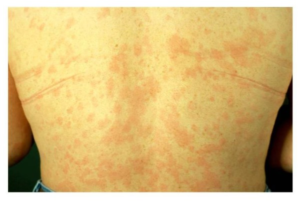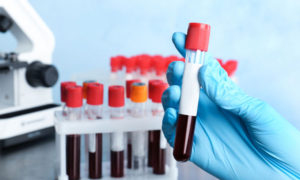Bay Biosciences provides high quality, clinical grade bio-samples, skin biopsy tissue sample, sera (serum), plasma and peripheral blood mononuclear cells (PBMC) bio-fluid specimens from patients diagnosed with Scleroderma disease.
The PBMC, sera (serum) and plasma samples are processed from patient’s peripheral whole-blood using customized processing protocols. The Scleroderma bio-specimens are collected from unique patients suffering from Scleroderma disease and provided to a valued pharmaceutical customer for research, development and drug discovery.

Scleroderma Overview
Scleroderma also known as Systemic Sclerosis is a rare, chronic connective tissue disease that involve the hardening and tightening of the skin and connective tissues, generally classified as one of the autoimmune rheumatic diseases that affect your joints tendons, ligaments, bones, and muscle. There are many different types of scleroderma. In some patients, scleroderma affects only the skin. But in many patients, scleroderma also harms structures beyond the skin, such as blood vessels, internal organs and the digestive tract (systemic scleroderma). Signs and symptoms vary, depending on the type of scleroderma.
Types of Scleroderma
There are two major classifications of scleroderma:
- Localized Scleroderma and
- Systemic Sclerosis.
- Other forms or sub classifications, each with its own characteristics and prognosis.
Signs and Symptoms of Scleroderma
Scleroderma’s signs and symptoms vary, depending on which parts of your body are affected, some types of scleroderma affect only the skin, while others affect the whole body.:
- Skin – Majority of the scleroderma patients experience a hardening and tightening of patches of skin. These patches may be shaped like ovals or straight lines, or cover wide areas of the trunk and limbs. The number, location and size of the patches vary by type of scleroderma. Skin can appear shiny because it’s so tight, and movement of the affected area may be restricted.
- Fingers or Toes – One of the earliest signs of Systemic Scleroderma is Raynaud’s disease, which causes the small blood vessels in the fingers and toes to contract in response to cold temperatures or emotional distress. When this happens, the fingers or toes may turn blue or feel painful or numb. Raynaud’s disease can also occurs in people who don’t have scleroderma.
- Digestive System – Scleroderma can cause a variety of digestive symptoms, depending on which part of the digestive tract is affected. If the esophagus is affected, the patient’s might have heartburn or difficulty swallowing. If the intestines are affected, the patient’s might have cramps, bloating, diarrhea or constipation. Some patients who have scleroderma may also have problems absorbing nutrients if their intestinal muscles aren’t properly moving food through the intestines.
- Heart, Lungs or Kidneys – Scleroderma can affect the function of the heart, lungs or kidneys to varying degrees, these problems, if left untreated, can become life-threatening.

Skin signs of scleroderma may include:
- Fingers or toes that turn blue or white in response to cold temperatures (Raynaud Phenomenon)
- Stiffness and tightness of skin of fingers, hands, forearm, and face
- Hair loss
- Skin that is darker or lighter than normal
- Small white lumps of calcium beneath the skin that sometimes ooze a white substance that looks like toothpaste
- Sores (ulcers) on the fingertips or toes
- Tight and mask-like skin on the face
- Telangiectasias, which are small, widened blood vessels visible beneath the surface on the face or at the edge of fingernails
Bone and muscle symptoms may include:
- Joint pain, stiffness, and swelling, resulting in loss of motion. The hands are often involved due to fibrosis around tissue and tendons.
- Numbness and pain pain in the feet.
Breathing problems may result from scarring in the lungs and can include:
- Dry cough
- Shortness of breath
- Wheezing
- Increased risk for lung cancer
Digestive tract problems may include:
- Difficulty swallowing
- Gastroesophageal reflux (GERD) or heartburn
- Bloating after meals
- Constipation
- Diarrhea
- Problems controlling stools
Heart problems may include:
- Abnormal heart rhythm (arrhythmias)
- Fluid around the heart
- Fibrosis in heart muscle, decreasing heart function
Kidney and genitourinary problems may include:
- Development of kidney failure
- Erectile dysfunction in men
- Vaginal dryness in women
Causes of Scleroderma
Scleroderma results from an overproduction and accumulation of collagen in body tissues. Collagen is a fibrous type of protein that makes up the body’s connective tissues, including skin. Exact cause of the abnormal collagen production is unknown, but the body’s immune system appears to play a role. The scleroderma disease is characterized by widespread deposition of collagen and other extracellular matrix proteins. This is believed to occur as a result of an abnormal immune response. Small vessels are involved early in the disease, accounting for the involvement of organs with a dense capillary network. This results in perivascular fibrosis and gradual luminal stenosis. Most probably, scleroderma is caused by a combination of factors, including immune system problems, genetics and environmental triggers.
Associated Diseases with Scleroderma
- CREST Syndrome
- Other Connective Tissue Disorders:
- Systemic Lupus Erythematosus (SLE)
- Polymyositis
- Dermatomyositis

Scleroderma Diagnosis
Complete physical exam is required by the doctors to look for signs of the disease and properly diagnose scleroderma.
The exam may show:
- Tight, thick skin on the fingers, the face or elsewhere.
- The skin at the edge of the fingernails may be looked at with a lighted magnifying glass for abnormalities of the small blood vessels.
- The lungs, heart and abdomen will be examined for abnormalities.
Scleroderma can cause small blood vessels in the kidneys to become narrowed. Problems with the kidneys can lead to high blood pressure and decrease function of the kidney.
Blood and urine tests may include:
- Antinuclear antibody (ANA) panel
- Scleroderma antibody testing
- ESR (sed rate)
- Rheumatoid Factor
- Complete blood count
- Metabolic panel, including creatinine
- Heart muscle tests
- Urinalysis
Other tests may include:
- Chest X-Ray
- CT scans of the lungs
- Electrocardiogram (ECG)
- Echocardiogram
- LFT Tests to see how well the lungs and gastrointestinal (GI) tract are functioning
- Skin biopsy
Scleroderma Treatment
There is no specific treatment for scleroderma, the doctors will assess the extent of disease in the skin, lungs, kidneys, heart, and gastrointestinal tract.
Patients with diffuse skin disease, rather than limited skin involvement may be more prone to progressive and internal organ disease. This form of the disease is classified as diffuse cutaneous systemic sclerosis (dcSSc). Body wide (systemic) treatments are most often used for this group of patients. Scleroderma patients are prescribed medicines and other treatments to control the symptoms and prevent complications.
Medicines used to treat progressive scleroderma include:
- Corticosteroids such as prednisone. However, doses above 10 mg per day are not recommended because higher doses may trigger kidney disease and high blood pressure (hypertension).
- Drugs that suppress the immune system such as mycophenolate, cyclophosphamide, cyclosporine or methotrexate.
- Hydroxychloroquine to treat arthritis.
Some patients with rapidly progressive scleroderma may be candidates for autologous hematopoietic stem cell transplantation (HSCT).
Other treatments for specific symptoms may include:
- Treatments to improve Raynaud phenomenon.
- Medicines for heartburn or swallowing problems, such as omeprazole.
- Blood pressure medicines, such as ACE inhibitors, for high blood pressure or kidney problems.
- Light therapy to relieve skin thickening.
- Medicines to improve lung function, such as bosentan and sildenafil.
- Physical therapy

Detailed clinical data, elevated levels of antibodies, serology, biomarkers, ESR, RF, ANA, SCL-70, genetic, pathology annotations, associated with the Scleroderma patient’s specimens is provided to a valued customer for drug discovery, development and research. The Scleroderma disease sera (serum), plasma and peripheral blood mononuclear cells (PBMC) biofluid samples were processed from patients peripheral blood using customized processing protocols provided by the researcher.
Bay Biosciences is a global leader in providing researchers with high quality, clinical grade, fully characterized human tissue samples, bio-specimens and human bio-fluid collections from cancer (tumor) tissue, cancer sera (serum), cancer plasma, cancer PBMC and human tissue samples from most other therapeutic areas and diseases.
Bay Biosciences maintains and manages it’s own bio-repository, human tissue bank (biobank) consisting of thousands of diseased samples (specimens) and from normal healthy donors available in all formats and types. Our biobank procures and stores fully consented, deidentified and institutional review boards (IRB) approved human tissue samples and matched controls.
All our human human tissue collections, human specimens and human bio-fluids are provided with detailed samples associated patient’s clinical data. This critical patient’s clinical data includes information relating to their past and current disease, treatment history, lifestyle choices, biomarkers and genetic information. Patient’s data is extremely valuable for researchers and is used to help identify new effective treatments (drug discovery & development) in oncology, other therapeutic areas and diseases. This clinical information is critical to demonstrate their impact, monitor the safety of medicines, testing & diagnostics, and generate new knowledge about the causes of disease and illness.
Bay Biosciences banks wide variety of human tissue samples and biological samples including cryogenically preserved -80°C, fresh, fresh frozen tissue samples, tumor tissue samples, FFPE’s, tissue slides, with matching human bio-fluids, whole blood and blood derived products such as serum, plasma and PBMC’s.
Bay Biosciences is a global leader in collecting and providing human tissue samples according to the researchers specified requirements and customized, tailor made collection protocols. Please contact us anytime to discuss your special research projects and customized human tissue sample requirements.
Bay Biosciences provides human tissue samples (human specimens) from diseased and normal healthy donors; including peripheral whole-blood, amniotic fluid, bronchoalveolar lavage fluid (BAL), sputum, pleural effusion, cerebrospinal fluid (CSF), serum (sera), plasma, peripheral blood mononuclear cells (PBMC’s), saliva, Buffy coat, urine, stool samples, aqueous humor, vitreous humor, kidney stones, renal calculi, nephrolithiasis, urolithiasis and other bodily fluids from most diseases including cancer. We can also procure most human bio-specimens and can do special collections and requests of human samples that are difficult to find. All our human tissue samples are procured through IRB approved clinical protocols and procedures.
In addition to the standard processing protocols Bay Biosciences can also provide human plasma, serum, PBMC bio-fluid samples using custom processing protocols, you can buy donor specific sample collections in higher volumes and specified sample aliquoting from us. Bay Biosciences also provides human samples from normal healthy donors, volunteers, for controls and clinical research, contact us Now.
日本のお客様は、ベイバイオサイエンスジャパンBay Biosciences Japan またはhttp://baybiosciences-jp.com/contact/までご連絡ください。
